仁爱英语七年级下册Unit6 Topic 1 SectionC 教案设计
- 格式:doc
- 大小:28.00 KB
- 文档页数:2
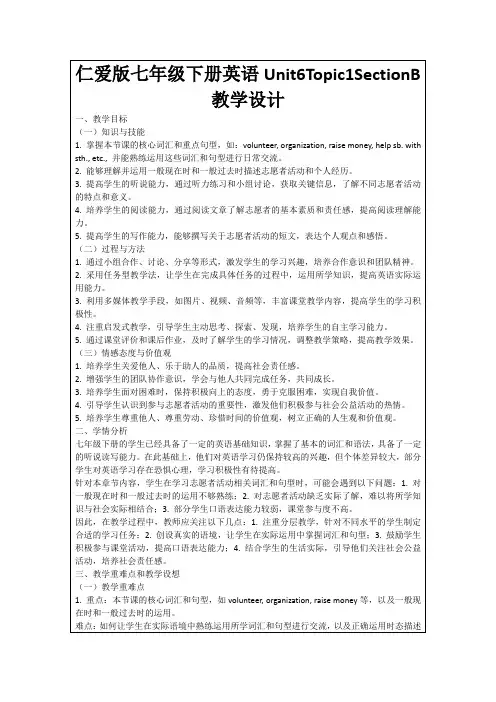
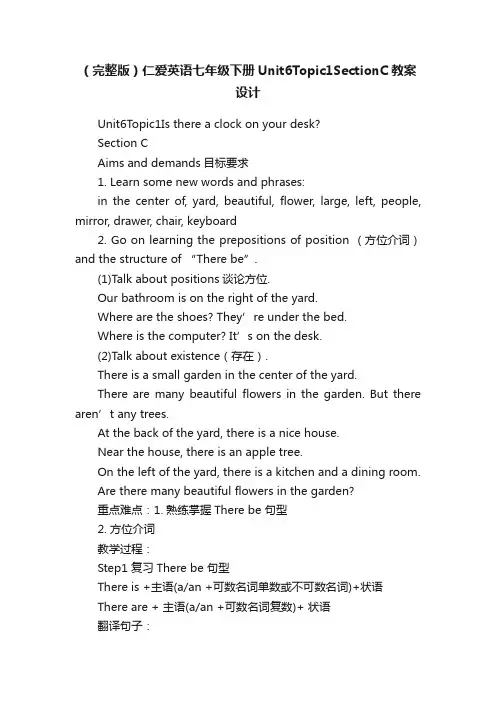
(完整版)仁爱英语七年级下册Unit6Topic1SectionC教案设计Unit6Topic1Is there a clock on your desk?Section CAims and demands目标要求1. Learn some new words and phrases:in the center of, yard, beautiful, flower, large, left, people, mirror, drawer, chair, keyboard2. Go on learning the prepositions of position (方位介词)and the structure of “There be”.(1)Talk about positions谈论方位.Our bathroom is on the right of the yard.Where are the shoes? They’re under the bed.Where is the computer? It’s on the desk.(2)Talk about existence(存在).There is a small garden in the center of the yard.There are many beautiful flowers in the garden. But there aren’t any trees.At the back of the yard, there is a nice house.Near the house, there is an apple tree.On the left of the yard, there is a kitchen and a dining room.Are there many beautiful flowers in the garden?重点难点:1. 熟练掌握There be 句型2. 方位介词教学过程:Step1 复习There be 句型There is +主语(a/an +可数名词单数或不可数名词)+状语There are + 主语(a/an +可数名词复数)+ 状语翻译句子:1)我家前面有条河。
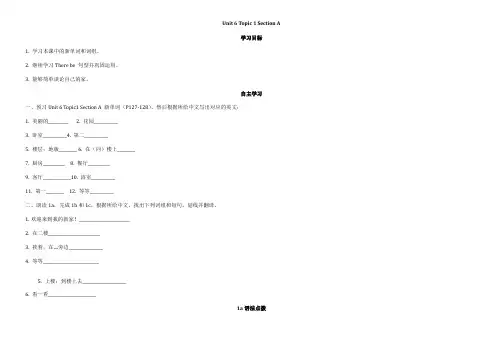
Unit 6 Topic 1 Section A学习目标1. 学习本课中的新单词和词组。
2. 继续学习There be 句型并巩固运用。
3. 能够简单谈论自己的家。
自主学习一、预习Unit 6 Topic1 Section A 新单词(P127-128),然后根据所给中文写出对应的英文:1. 美丽的__________2. 花园____________3. 卧室____________4. 第二____________5. 楼层;地板_________6. 在(向)楼上_________7. 厨房___________ 8. 餐厅___________9. 客厅______________10. 浴室____________11. 第一_________ 12. 等等____________二、朗读1a,完成1b和1c。
根据所给中文,找出下列词组和短句,划线并翻译。
1.欢迎来到我的新家!_________________________2. 在二楼__________________________3. 挨着;在....旁边_________________4. 等等____________________________5. 上楼;到楼上去______________________6. 看一看________________________1a语法点拨1.--Where is your bedroom? --It’s on the second floor. There is a study next to my bedroom.你的卧室在哪儿?它在二楼,有一个书房紧挨着我的卧室。
(1)on the second floor “在二楼”,second 在此是序数词,意为“第二”,前面需要加定冠词the。
second 还可作名词,意为“秒”,表时间。
(2)study 在此是名词,意为“书房”,复数形式为studies。
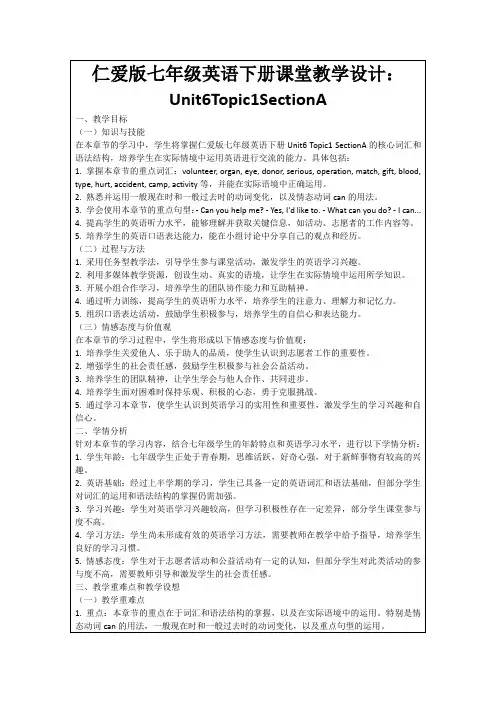
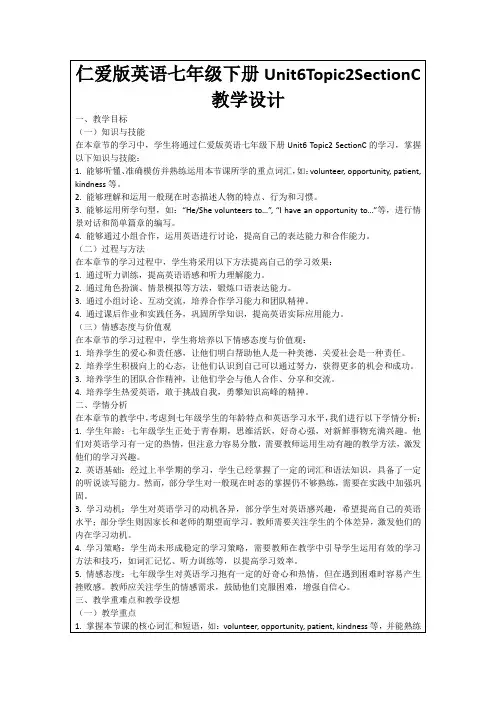
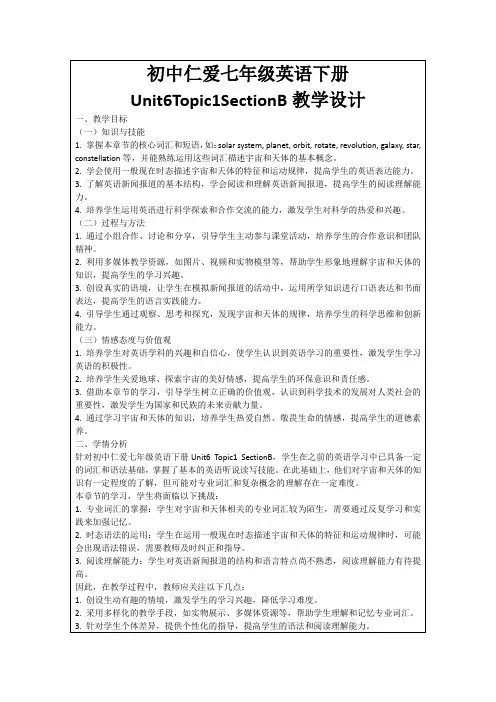
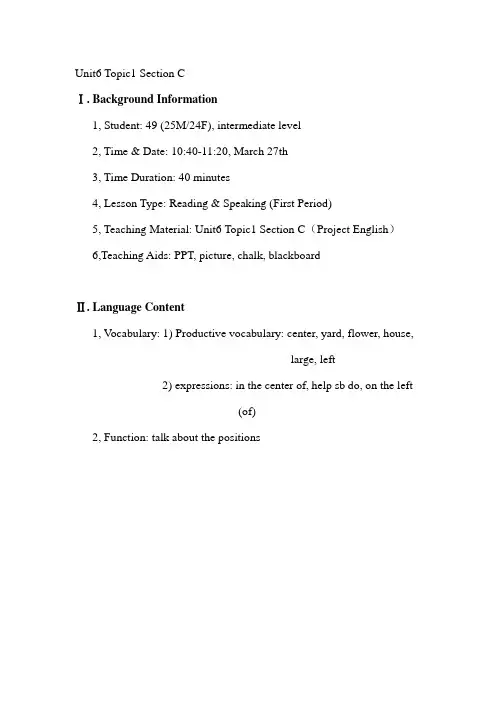
Unit6 Topic1 Section CⅠ. Background Information1, Student: 49 (25M/24F), intermediate level2, Time & Date: 10:40-11:20, March 27th3, Time Duration: 40 minutes4, Lesson Type: Reading & Speaking (First Period)5, Teaching Material: Unit6 Topic1 Section C(Project English)6,Teaching Aids: PPT, picture, chalk, blackboardⅡ. Language Content1, V ocabulary: 1) Productive vocabulary: center, yard, flower, house,large, left2) expressions: in the center of, help sb do, on the left(of)2, Function: talk about the positionsⅢ. Teaching Objectives1, Instructional ObjectivesAt the end of the class, the students should be able to:1) know how to use phrases to talk about the positions2) know that descring the positions must be done according to acertain order2, Educational ObjectivesAt the end of the class, the students should be able to:1) be confident when talking about positions3, Personal ObjectivesAt the end of the class, the teacher should be able to:1) be better at designing activities to help be more interested inEnglish learningⅣ. Focal and Difficult Point1, Focal point: 1) understand the description in the passage2) know how to use the phrases2, Difficult point: 1) how to describe the position of a certain placeⅤ. Teaching ProcedureStage 1: Pre-reading (16 min)Step 1: Getting in (1 min)Purpose: to draw students’ attention and arouse students’ interestInstructions:T: Good morning class! Do you remember what we learned last class. Let's havea short review.Step 2: Presenting pictures (8 min)Purpose: to lead students to make sentence from the picture using the phrases learned last classInstructions:T: Look at the picture, in picture one,we can see学校在医院的右边, how to say it in English.( at the back of, on the right of, between,)Step 3 Present the students more pictures and key words to lead them to make Sentences (3 min)Purpose: to help students use the expressions more flexiblyInstructions:T: There several pictures, try to make more sentences.Step 4 Presenting the pictures to explain the new words (3 min)Purpose: helping the students understand the new phrases, andreading more smoothlyT: This time, look at the picture and the sentence, try your best to understand the words in red. (center, in the center of, yard house, left )Stage 2 while-reading (12 min)Step 1 skimming (2 min)Purpose: to help students to get the main idea of the passageT: I'll give you two minutes to read this passage and the pictureStep 2 Scanning (4 min)Purpose: to lead the students to finish the exercise in 1BInstructions:T: This time I want you to read the passage carefully and finish the exercise in 1B Step 3 Listening and drawing (6 min )Purpose: to help students to understand the description of positions better Instructions:T: let's read the passage together.T: Now, close your book, and take out a piece of paper, Listen to the tape, I'll pause it for you, try your best to draw the picture of the house.Stage 3 Post-reading (12 min)Step 1 Discuss the question in 1A(3 min)Purpose: to lead student to think of their ideal houseInstructions:T: Do you like the home in the picture? Why? Discuss with your partner.Step 2 draw a picture of ideal house(4 min)Purpose: prepare for the speaking taskInstructions:T: Now draw a picture of your ideal house, 画一个你最想要的房子, 可以有swimming pool garden, 尽可能地设计出你想要的房子Step 3 Speaking (5min)Purpose: to train the students how to describe the positionsInstructions:T: Who'd like to share his idea with us, you tell us what your house is likeaccording to the picture and then I'll show your picture to othersⅥ. Blackboard Designleft on the left of, on the leftcenter in the center ofHouseYardFlowerLarge。
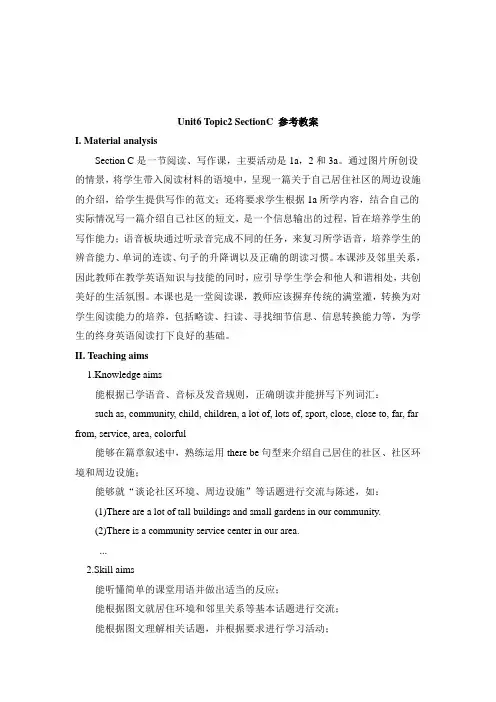
Unit6 Topic2 SectionC 参考教案I. Material analysisSection C是一节阅读、写作课,主要活动是1a,2和3a。
通过图片所创设的情景,将学生带入阅读材料的语境中,呈现一篇关于自己居住社区的周边设施的介绍,给学生提供写作的范文;还将要求学生根据1a所学内容,结合自己的实际情况写一篇介绍自己社区的短文,是一个信息输出的过程,旨在培养学生的写作能力;语音板块通过听录音完成不同的任务,来复习所学语音,培养学生的辨音能力、单词的连读、句子的升降调以及正确的朗读习惯。
本课涉及邻里关系,因此教师在教学英语知识与技能的同时,应引导学生学会和他人和谐相处,共创美好的生活氛围。
本课也是一堂阅读课,教师应该摒弃传统的满堂灌,转换为对学生阅读能力的培养,包括略读、扫读、寻找细节信息、信息转换能力等,为学生的终身英语阅读打下良好的基础。
II. Teaching aims1.Knowledge aims能根据已学语音、音标及发音规则,正确朗读并能拼写下列词汇:such as, community, child, children, a lot of, lots of, sport, close, close to, far, far from, service, area, colorful能够在篇章叙述中,熟练运用there be句型来介绍自己居住的社区、社区环境和周边设施;能够就“谈论社区环境、周边设施”等话题进行交流与陈述,如:(1)There are a lot of tall buildings and small gardens in our community.(2)There is a community service center in our area....2.Skill aims能听懂简单的课堂用语并做出适当的反应;能根据图文就居住环境和邻里关系等基本话题进行交流;能根据图文理解相关话题,并根据要求进行学习活动;能写出介绍自己居住的社区环境的短文。
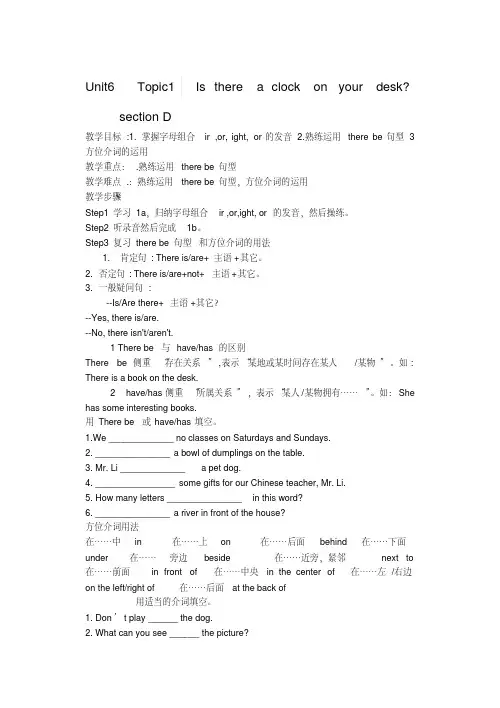
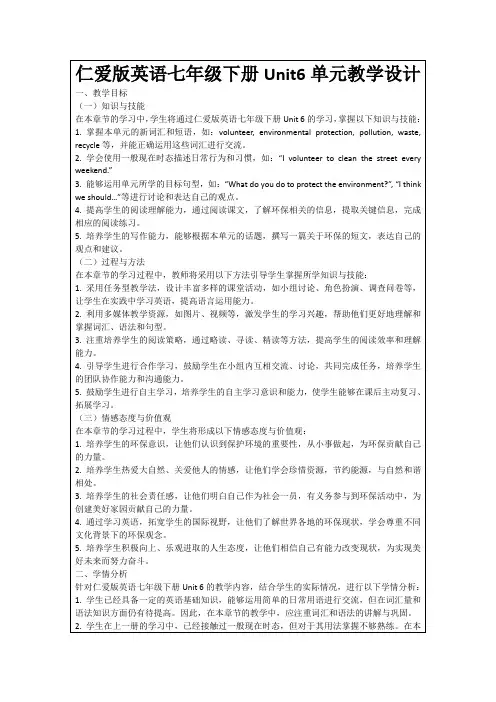
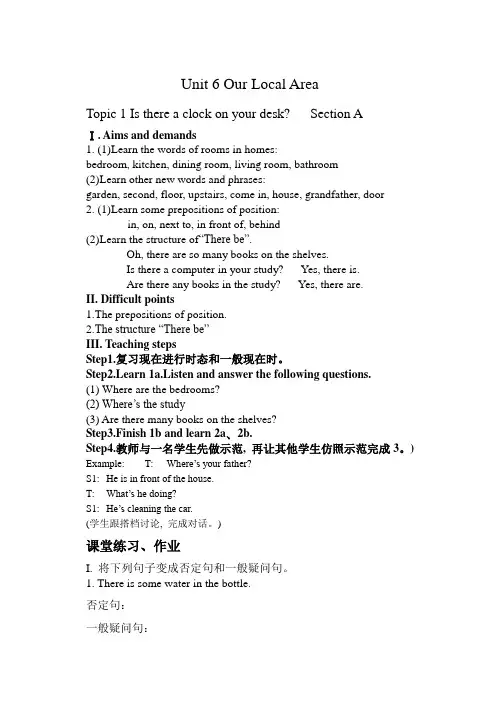
Unit 6 Our Local AreaTopic 1 Is there a clock on your desk? Section AⅠ. Aims and demands1. (1)Learn the words of rooms in homes:bedroom, kitchen, dining room, living room, bathroom(2)Learn other new words and phrases:garden, second, floor, upstairs, come in, house, grandfather, door2. (1)Learn some prepositions of position:in, on, next to, in front of, behind(2)Learn the structure of“There be”.Oh, there are so many books on the shelves.Is there a computer in your study? Yes, there is.Are there any books in the study? Yes, there are.II. Difficult points1.The prepositions of position.2.The structure “There be”III. Teaching stepsStep1.复习现在进行时态和一般现在时。
Step2.Learn 1a.Listen and answer the following questions.(1) Where are the bedrooms?(2) Where’s the study(3) Are there many books on the shelves?Step3.Finish 1b and learn 2a、2b.Step4.教师与一名学生先做示范, 再让其他学生仿照示范完成3。
仁爱版英语七年级下册Unit 6 topic 1 section C 教学设计一. 教材分析仁爱版英语七年级下册Unit 6 topic 1 section C主要介绍了中国的传统节日,如春节、清明节、端午节、中秋节等。
本节课主要通过讲述这些节日的习俗和食物,让学生了解中国的传统文化,提高他们对英语学习的兴趣。
本节课的主要语言点是一般现在时态的被动语态和一般过去时态的被动语态。
二. 学情分析七年级的学生已经掌握了一般现在时态和一般过去时态,对本节课的语言点有一定的了解。
但是,对于一些具体的习俗和食物的表达可能还不够熟悉。
因此,在教学过程中,需要结合学生的实际情况,适当调整教学内容和教学方式。
三. 教学目标1.知识目标:–掌握一般现在时态的被动语态和一般过去时态的被动语态。
–了解中国的传统节日及其习俗和食物。
2.能力目标:–能够用英语描述中国的传统节日及其习俗和食物。
–能够听懂并正确回答有关中国传统节日的问题。
3.情感目标:–培养学生对中国传统文化的兴趣。
–增强学生对英语学习的热情。
四. 教学重难点•一般现在时态的被动语态和一般过去时态的被动语态。
•中国传统节日的习俗和食物的表达。
•一般过去时态的被动语态的运用。
•一些具体习俗和食物的英语表达。
五. 教学方法1.情境教学法:通过设定情境,让学生在实际语境中学习和运用语言。
2.任务型教学法:通过完成任务,培养学生的主体性和合作精神。
3.交际法:通过师生互动和生生互动,提高学生的口语表达能力。
六. 教学准备1.教师准备:–制作课件和教学素材。
–准备相关的传统文化资料。
2.学生准备:–预习相关课文内容。
–搜集有关中国传统节日的资料。
七. 教学过程1.导入(5分钟)–教师通过提问方式引导学生回顾一般现在时态和一般过去时态,为新课的学习做好铺垫。
2.呈现(10分钟)–教师通过课件展示中国传统节日的图片,引导学生用英语描述这些节日。
3.操练(15分钟)–教师设计一些练习题,让学生练习一般现在时态的被动语态和一般过去时态的被动语态。
仁爱版英语七年级下册Unit 6 topic 1 section A 教学设计一. 教材分析仁爱版英语七年级下册Unit 6 topic 1 section A主要讲述了一对兄妹David和Sarah在周末的计划。
本节课的主要内容是让学生掌握一般将来时态的构成和用法,以及如何用英语描述周末计划。
教材通过真实的语境,引导学生学会用英语进行日常交流,培养他们的语言运用能力。
二. 学情分析七年级的学生已经学习了一般现在时态和一般过去时态,对英语学习有了一定的基础。
但部分学生可能对一般将来时态的构成和用法还不够熟悉,需要老师在教学中进行引导和巩固。
此外,学生们的口语表达能力参差不齐,需要在课堂操练环节给予充分的练习和鼓励。
三. 教学目标1.知识目标:–能正确运用一般将来时态描述周末计划。
–能听懂、会说、会读本节课的重点词汇和句型。
2.能力目标:–能用英语进行简单的日常交流,提高口语表达能力。
–能通过小组合作,完成对话任务,提高团队协作能力。
3.情感目标:–培养学生的学习兴趣,激发他们学习英语的积极性。
–培养学生的团队精神,提高他们的人际沟通能力。
四. 教学重难点•一般将来时态的构成和用法。
•本节课的重点词汇和句型。
•一般将来时态的运用,尤其是在描述具体情境时的运用。
•学生口语表达能力的提高,尤其是对于时态的准确运用。
五. 教学方法1.情境教学法:通过设置真实的生活情境,让学生在实际语境中学习英语,提高他们的语言运用能力。
2.任务型教学法:通过小组合作完成任务,激发学生的学习兴趣,培养他们的团队协作能力。
3.交际法:注重师生互动,生生互动,提高学生的口语表达能力。
六. 教学准备1.教学课件:制作课件,包括本节课的重点词汇、句型和情境对话。
2.教学道具:准备与本节课相关的生活用品,如图片、卡片等。
3.听力材料:准备与本节课相关的听力材料,以便进行听力训练。
七. 教学过程1.导入(5分钟)–老师与学生进行简单的英语交流,复习一下之前学过的一般现在时态和一般过去时态。
仁爱版七年级下册Unit6Topic 1Section CMy Home教学设计科目英语授课教师授课时间授课班级授课内容仁爱版七年级下册Unit6Topic 1Section C My Home教材分析本课是话题一的第三课时。
本课的主要活动是1a和2。
通过图文并茂的方式介绍“My Home”,进一步扩大学生的词汇、学习方位介词短语并复习巩固there be句型;本课涉及到谈论学生的家的房间结构布置,因此教师应积极创设真实的情景,让学生在情景中反复操练已学到的关于方位和家的结构、摆设的相关词汇,,然后用于真实写作。
学情分析本班学生有较好的英语基础和交际能力,也熟悉小组合作等学习模式,英语课堂是十分活跃高效的。
对英语学习有较浓厚的兴趣,学习非常积极,,不仅需要学生掌握如何用英文来谈论房子相关结构,还鼓励学生通过小组合作探究等活动操练,学生们能够自如地学会描述自己房子。
教学目标1.语言能力目标:1.使学生知道如何利用一些重点单词和短语描述“我家”,例如:在中央,在左边等等。
2. 学习能力目标:知道写作的方法及懂得如何进行写作。
3. 思维品质目标:(1)学生通过小组合作和分享活动,习得解决问题的能力。
(2)懂得如何批改作文并培养学生的合作探究精神。
教学重点学会如何利用一些重点单词和短语描述“我家”并懂得如何进行写作,学会自评和互评作文。
教学难点学会如何利用一些重点单词和短语描述“我家”并懂得如何进行写作,学会自评和互评作文。
教学策略运用口述,写作,小组合作探究及小组对话完成, 同时运用Pre-writing,While writing和Post writing写作课教学模式完成目标任务。
教学资源Multimedia, blackboard, PPT。
仁爱版七年级英语下册Unit6Topic1SectionC教案-新版Unit6 Topic1 SectionC教案I. Material analysis本课是话题一的第三课时。
本课的主要活动是1a和2。
通过图文并茂的方式介绍“My Home”,进一步扩大学生的词汇、学习方位介词短语并复习巩固there be句型;还将学习用how many和how much对物质(名词)的数和量进行提问。
此外,语音板块根据音标拼写相应的单词,复习字母组合的发音规律,培养学生单词的拼读和拼写能力。
本课涉及到谈论学生的家的房间结构布置,因此教师应积极创设真实的情景,让学生在情景中反复操练已学到的关于方位和家的结构、摆设的相关词汇。
II. Teaching aims1.Knowledge aims能根据已学语音、音标及发音规则,正确朗读、拼写和运用下列词汇和短语:center, in the center of, yard, flower, house, large, left, model, only能够在小组合作活动中,根据音标拼写出相应的单词,培养单词的拼读和拼写能力;能够正确使用there be句型、特殊疑问句、一般疑问句及其肯定和否定回答以及表示方位关系的介词短语,如:near, next to, in the center of, at the back of, on the left of能够就“物品摆设、存在”等交际功能进行交流与对话操练,正确运用how many 和how much对可数和不可数名词进行提问,如:(1)—Is there any water in the bottle?—Yes, there is.(2)—How much water is there?—Only a little.(3)—How many model planes are there?—There are three....2.Skill aims能识别出不同的语调,如陈述句和疑问句等;能听懂谈论房间、室内摆设的表达,并做出恰当回应;能对房间、室内摆设进行简单的交流;能在口头表达中做到发音清晰,语音语调准确;能在图画的帮助下进行阅读,并按要求进行语言活动;能正确拼读单词,注意单词重音;能准确写出黑体单词和词组;能根据范文写出介绍自己家的小短文。
仁爱英语七年级(下)Unit 6 Topic 1 Section C重庆市石柱县南宾中学校——陈华兵Teaching Aims:1.New words and expressions:yard, beautiful, flower, large, left, people, drawer, chair, keyboard ,in the center of2. Go on learning the prepositions of position.3. Go on learning the structure of “There be”.4. Write “My Home” according to 1a .Teaching Points:The prepositions of position and the structure of “There be”Teaching Difficulties:Write “My Home” according to 1a .Teaching Aids:Computer , pictures and multimedia .Emotional attitude and Values :Let the students love their familes and parents .Teaching Procedures:Step 1. Review (5 minutes)1.Let the student on duty make a report .2.Let students talk in pairs freely.3.Ask and answer :T: What’s in the tree ?S: There is /are (a cat/some birds) in it .T: What is/are it /they doing ?S: It is/They are ….…..Step 2. Presentation(20minutes)1. To teach new words and phrases.(1)center ['sentə]名词n. 中心; 中央, 中心点; in the center of 在……中心。
Unit6Topic1Is there a clock on your desk?
Section C
Aims and demands目标要求
1. Learn some new words and phrases:
in the center of, yard, beautiful, flower, large, left, people, mirror, drawer, chair, keyboard
2. Go on learning the prepositions of position (方位介词)and the structure of “There be”.
(1)Talk about positions谈论方位.
Our bathroom is on the right of the yard.
Where are the shoes? They’re under the bed.
Where is the computer? It’s on the desk.
(2)Talk about existence(存在).
There is a small garden in the center of the yard.
There are many beautiful flowers in the garden. But there aren’t any trees.
At the back of the yard, there is a nice house.
Near the house, there is an apple tree.
On the left of the yard, there is a kitchen and a dining room.
Are there many beautiful flowers in the garden?
重点难点:1. 熟练掌握There be 句型
2. 方位介词
教学过程:
Step1 复习There be 句型
There is +主语(a/an +可数名词单数或不可数名词)+状语
There are + 主语(a/an +可数名词复数)+ 状语
翻译句子:
1)我家前面有条河。
__________________________________. 2)杯子里有一些橙汁。
__________________________________.
3桌子上有些苹果。
____________________________________. 4)我们班有41名学生。
_________________________________. Step2 阅读训练:阅读1a完成1b
Step 3 Learn 1a
知识点:
1)love 意为‘爱,喜爱’当表示经常性的,习惯性的喜欢,后面常加动词的-ing形式,即love doing sth ; 若表示特定的或具体某一次的喜欢则加动词不定式,即love to do sth.
Eg, 我喜欢游泳,但今天我不想游泳。
I love swimming, but I don't love to swim today.
2)on the left of 在...的左边
相似短语:on the right of in the center of 在...中央at the back of 在...后面
Step 4 learn part2 Work alone
Finish part3
Step 5 练习巩固
1.There is much money in the d_________ of the desk.
2.Kate likes w__________ TV in the living room.
3.Oh! Y our face is so red. Look at yourself in the m_______.
4.---- Where is your computer?
----It's _______ the desk.
A. under
B. in
C. on
5.---- Where is my ball, mum?
-----It's _____ the door.
A. on B behind C next to
6.My pet is playing _______ the ball.
A in
B with
C for
7.---Mom, where are my sports shoes?
---- They're _____ your bed.
A under
B in
C behind
完成句子:
1.他们在起居室里看电视。
They are _______ ___________ ________ in the living room.
2.格林一家正在餐厅吃晚餐。
The Greens ________ ______ ________ in the _________ _________.
3.我爸爸的新大衣在衣橱里。
My father's ______ _______ is _____ the wardrobe(衣橱)。
4.我房子前面有一个小花园。
_______ _______ a small garden ______ _______ ______my house.
反思:。